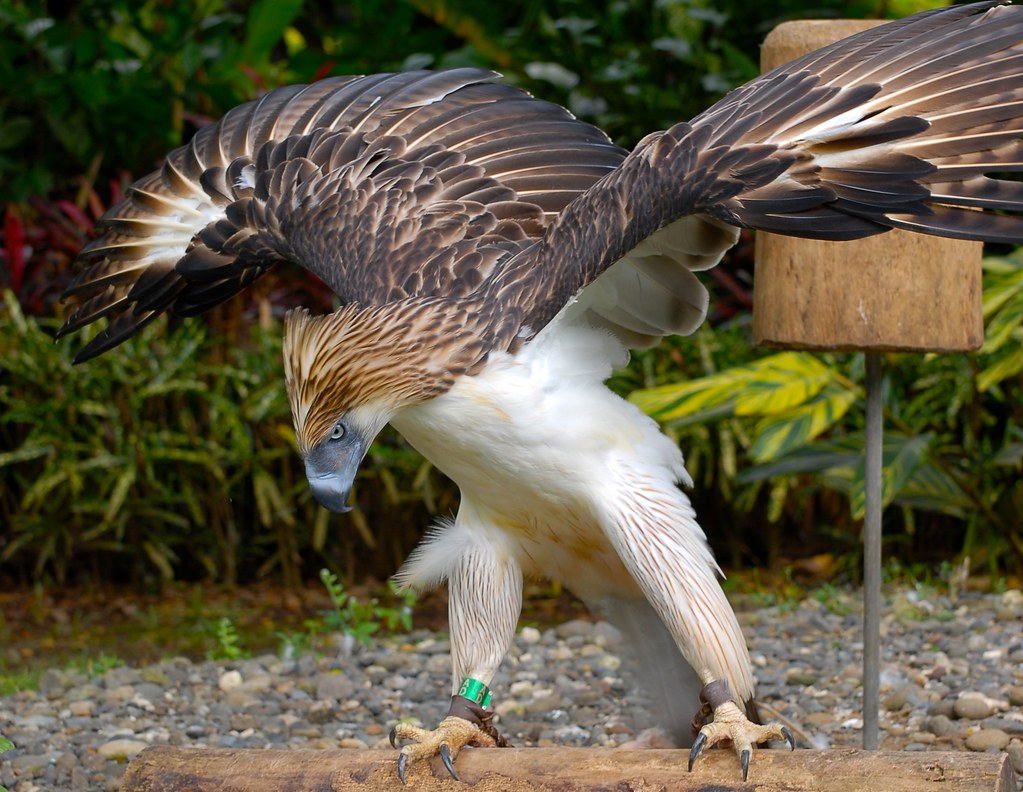

Fortunately, there are concerned and dedicated organizations out there who are committed to raising awareness and conserving one of the Philippines' greatest national treasure. The Philippine Eagle may not be found in the wild soon enough if this continues. Several cases of such have occurred multiple times where eagles are treated for gunshot wounds then released to the wild, only to be shot again. Another eagle, named Kagsabua, was released on March 6, 2008, but was shot and eaten by a farmer. Kabayan is the first captive-bred bird released in the wild in 2004 on Mindanao but was accidentally electrocuted in January 2005. Since then, numerous programs and organizations have been established to help protect and conserve the rare bird of prey. The first program that was started to help preserve the species was in 1969 called the Monkey-eating Eagle Conservation Program by the government. He was a representative of the World Wildlife Fund and helped persuade the government to protect the eagle. This caught the attention of Charles Lindbergh, an American aviator best known for crossing the Atlantic alone and without stopping in 1927. Alvarez, the director of the Parks and Wildlife Office, were the first to bring international attention about the decline in numbers of the Philippine Eagle in 1965. Rabor, a Filipino ornithologist and Jesus A. Based on current genetic studies, it has no subspecies left among the living species of eagles in the world, making it very unique.ĭioscoro S. In honor of Jeffery Whitehead, John's father who funded his expeditions, he named the species Pithecophaga jefferyi. Along with his servant, Juan, they observed the bird then collected it a few weeks later. The Philippine Eagle was first discovered by a British explorer and naturalist, John Whitehead in 1896 in Paranas, Samar. When the egg hatches after 62 days (2 months), both parents take turns in hunting and feeding their newly hatched eaglet. Both of the parents take part in the incubation of the egg, but the female does a majority of the incubating. The male sexually matures at seven years of age and the female at five years. A nesting pair can produce a single egg every two years. Like most eagles, they are monogamous (loyal to one mate for life). Its blue-gray eyes have the capacity to see eight times the distance compared to the human eye. It has clearer and sharper eyesight than humans. In recent studies, the bird also preys on bats, snakes, rodents, pigs, monitor lizards, and flying lemurs. They are also known to hunt pigs and small dogs.Although given the name " Monkey-eating Eagle", the Philippine Eagle does not only eat monkeys, contrary to popular beliefs. These species predominantly feed on monkeys, birds, Luzon, cloud-rats, flying foxes, monitor lizards, snakes, colugo, civets, owls, and hornbills. The lifespan of Philippine eagle ranges from 30 – 60 years.Deforestation is one of the major causes of its extermination. With only an estimated 400 left in the wild, the race is on to save the Philippine eagleone of the biggest and strongest raptors in the. The Philippine eagles range is about 146,000 sq. Watch an endangered eagle chick grow up in rare video. They are also found in montane forests and lowlands with a height of more than 1,800 m (5,900 feet). Around 80 – 230 breeding pairs exist in these places. These types of eagles are native to Philippine and are largely found in Mindanao, Luzon, Leyte, Samar, Mount Apo, Madre National Park, and Kitanglad National Park.Philippine Eagle Where Do Philippine Eagles Live The wingspan of Philippine eagles measure 184 – 202 cm (6.02 – 6.63 feet).The average weight of these males is around 4.5 kg (9.9 lb), while the females are 6 kg (13 lb) by weight. SAN FERNANDO, Pampanga, Philippines The celebration of Philippine Eagle Week has renewed hope in Central Luzon following sightings of a raptor that has been missing following its release in the.Like other raptors, females are 10% greater than males. One of the longest Philippine eagles measured 112 cm (3.67 feet) under captivity.

The average length of male is about 95 cm (3.12 feet), while the females are 105 cm (3.44 feet) long.There is no significant difference between the chicks and adults.The plumage is brown and white, with undersides pure white and yellow legs.Philippine eagles weigh around 4.7 – 8 kg (10 – 18 lb).The length of the Philippine is around 86 – 102 cm (2.82 – 3.35 feet).


 0 kommentar(er)
0 kommentar(er)
